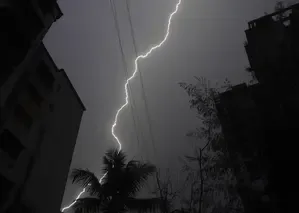How Did Over 40 Sheep and Goats Die in a Lightning Strike in J&K’s Ganderbal?

Synopsis
A devastating lightning strike in Ganderbal district, Jammu and Kashmir, resulted in the tragic death of over 40 sheep and goats belonging to a nomadic community. This event highlights the impact of severe weather patterns on local livestock and agriculture, as the region faces ongoing climatic challenges and crop damage.
Key Takeaways
- Lightning strikes can have devastating effects on livestock.
- The nomadic Bakarwal community relies heavily on their livestock for livelihood.
- Extreme weather is damaging crops and properties in the region.
- Climate change poses significant risks to agriculture.
- Food security is threatened due to reduced cultivation areas.
Srinagar, May 20 (NationPress) In a tragic incident, more than 40 sheep and goats lost their lives on Tuesday due to a lightning strike in Jammu and Kashmir’s Ganderbal district.
According to officials, the animals were struck by lightning in the Hariganwan area of Ganderbal district.
The livestock were owned by a nomadic 'Bakarwal' (Goatherd) community member named Abdul Wahid Khatana, who hails from Sunderbani in Rajouri district. He was tending to his flock in Chechi Pati when the lightning struck following a brief thunderstorm in the area.
Over the past three days, gusty winds have caused significant damage to both private and public properties across the Valley.
The region has been experiencing unusually high daytime temperatures, reaching up to 32.6 degrees Celsius, resulting in the creation of a low-pressure zone over the Valley.
This climatic condition has led to high-speed winds flowing into the area to balance the pressure-temperature dynamics.
Furthermore, an accompanying hailstorm has inflicted severe damage on the apple crops, particularly in the southern districts of Kulgam, Pulwama, Shopian, and Anantnag.
Hailstorms have also caused significant harm to paddy nurseries, as the paddy crop relies on transplanting saplings from nurseries to fields.
The paddy season spans from early May to mid-October, during which the crop must be sown, transplanted, and harvested.
Failure to adhere to this schedule can jeopardize the success of the paddy crop and its grain production.
Rice serves as the staple diet for the people in the Valley. However, with the expansion of urban infrastructure leading to a reduction in cultivable land, the area dedicated to paddy cultivation has sharply declined. This has increased reliance on government-operated ration shops, where rice is provided at varying rates based on individuals' financial conditions.





